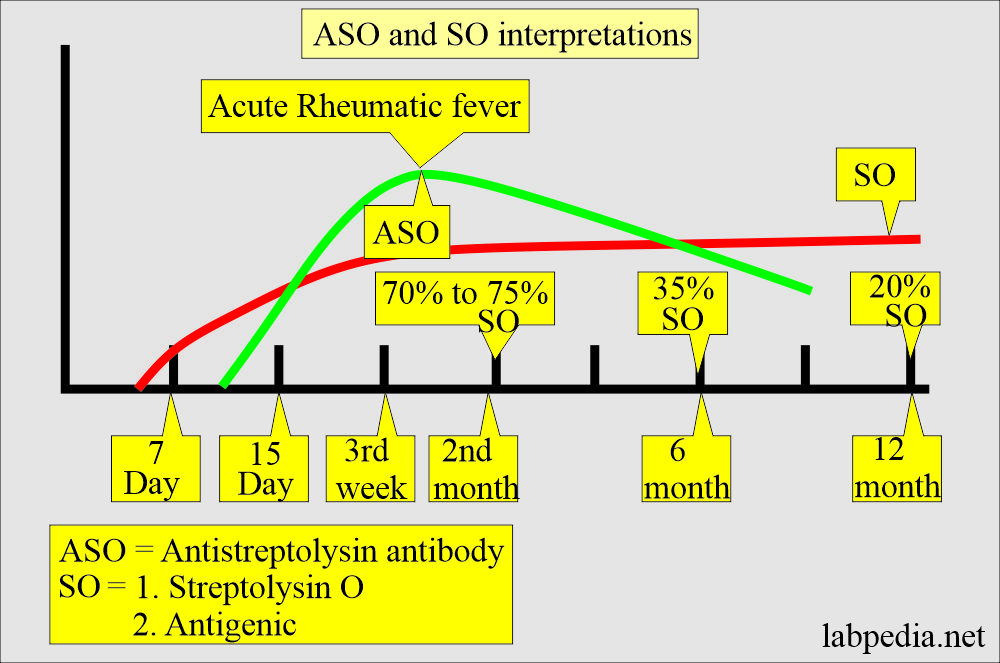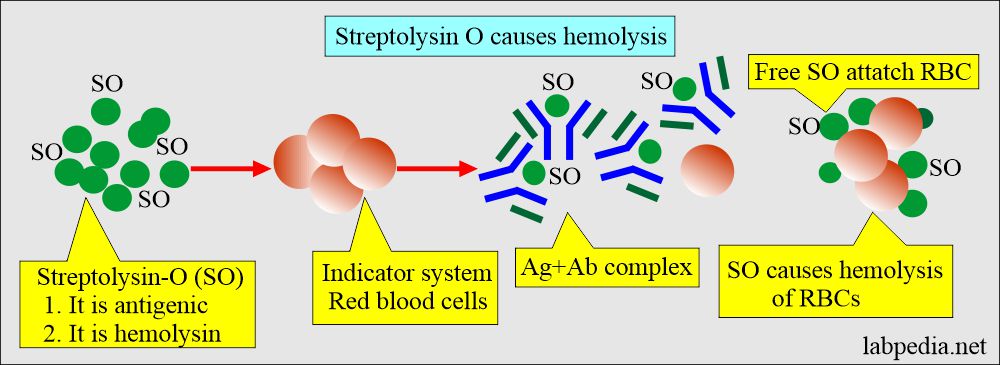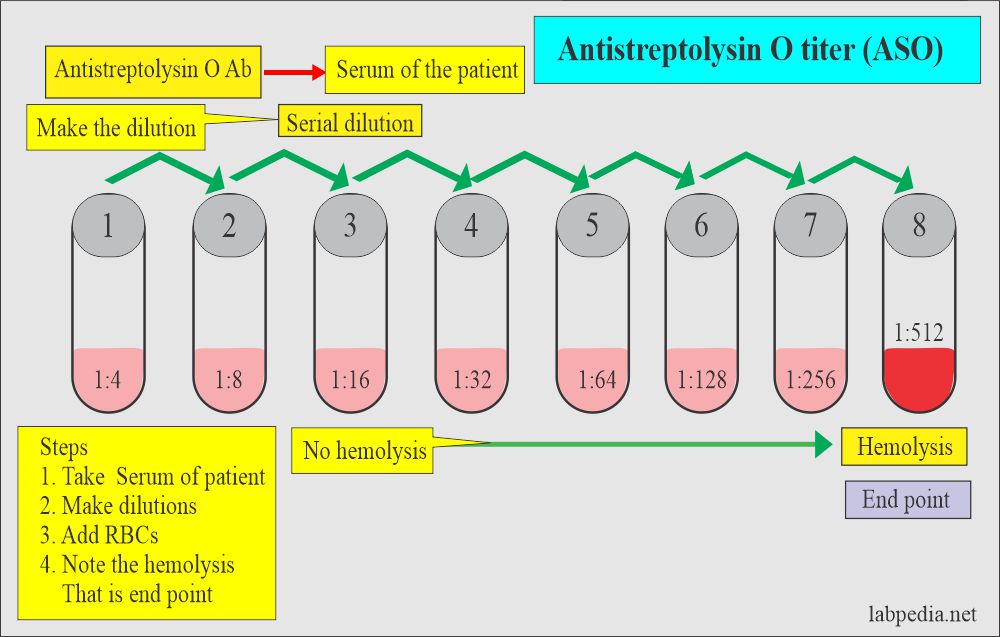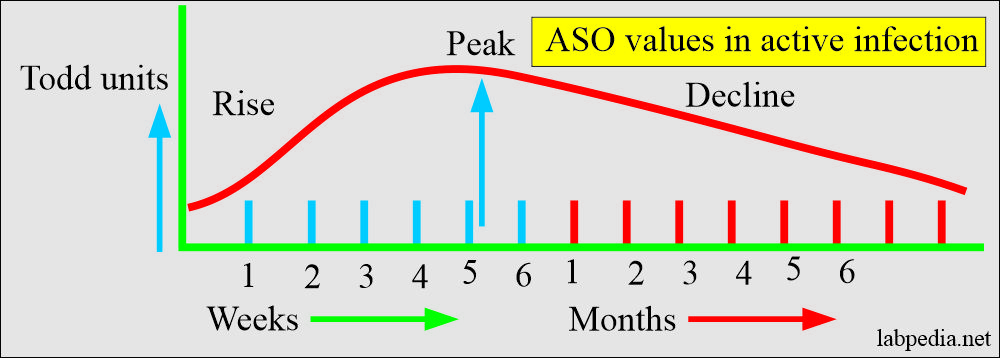ASO Titer (Antistreptolysin O titer)
Antistreptolysin O titer (ASO)
Sample for Antistreptolysin O titer (ASO)
- The test is done on the patient’s serum (clotted blood 3 to 5 ml).
- A random sample can be taken.
- Avoid hemolysis.
Purpose of the test (Indications) for Antistreptolysin O titer (ASO)
- To diagnose exposure to Streptococcal infection.
- To diagnose poststreptococcal diseases like:
- Glomerulonephritis.
- Rheumatic fever.
- Bacterial Endocarditis.
- Scarlet fever.
- A significant level was seen in glomerulonephritis and rheumatic fever.
Precautions for Antistreptolysin O titer (ASO)
- Avoid the drug-like steroid and antibiotics that decrease the ASO titer.
- Increased beta-lipoprotein inhibits streptolysin O and gives a false high ASO titer.
- Early injection of penicillin prevents the rise of titer.
Principle for Antistreptolysin O titer (ASO)
- Lancefield group A streptococci are also known as streptococcus pyogenes.
- Group A β-streptococci produce various infections; the most common is acute pharyngitis.
- It can produce scarlet fever, erysipelas, vesicular cellulitis, and puerperal fever.
- There are few reports showing conditions like staphylococcal toxic shock syndrome.
- Beta-hemolytic group A streptococci produce many enzymes that can contribute to their pathogenicity. Two of these are:
Streptolysin O:
- O stands for oxygen-labile, as it is inactivated by oxygen.
- Streptolysin O is produced after 7 to 10 days of the infection, and antibodies start to appear.
- At the end of 2 months, only 70% to 75% of the tests are positive.
- At the 6 months, 35% are positive.
- At 12 months, 20% are positive.
- This enzyme destroys the red blood cells and white cells. This is why it is called β-hemolytic group A streptococci and has the ability for beta-hemolytic ability.
- This enzyme is antigenic.
- Patients develop an anti-streptolysin antibody (ASO-antibody).
- There is the highest level of ASO titer during the third week of the infection for acute rheumatic fever.
- At this stage, positivity is 80% to 85%, and antibodies start declining later.
Streptolysin S:
- The “S” stands for oxygen stable.
- This can cause beta hemolysis.
- This is not antigenic.
- ASO is measured by latex agglutination or haemagglutination procedure.
- This test will measure the antibodies against Streptolysin O, antigenically produced by the Group A beta-hemolytic streptococci.
- RBCs are added as an indicator system.
- The ASO antibody may be found in the blood weeks or months after the infection has gone away.
Toxins of Beta-Streptococci:
- Group A-beta streptococci can be isolated from throat or nasopharynx culture in 15% to 20% (range 11% to 60%) of normal children.
- Taking two swabs instead of one will increase the positivity of the culture.
- Group A streptococci are always sensitive to penicillin and in vitro sensitivity testing.
- Streptolysin O is an extracellular toxin produced by many of the streptococci groups, particularly by group A β-hemolytic streptococci.
- Streptolysin O has the ability to destroy (hemolysis) the red blood cells.
- The Streptolysin O enzyme is antigenic, and the immune system will produce antibodies such as the Antistreptolysin O antibody (ASO).
The appearance of ASO and SO:
- ASO appears in the serum after one week to one month of streptococcal infection.
- This ASO is a neutralizing antibody.
- ASO has no value for the diagnosis of acute streptococcal infection.
- The rising serial titer of ASO over weeks, followed by a slow fall in titer, is more significant for streptococcal infection.
- After 6 months, only 30% of the patient show abnormal titer.
- The highest level of ASO is seen in glomerulonephritis and rheumatic fever.
- A fourfold rise in the titer is significant for acute and convalescent patients.
- The 500 to 5000 Todd units/mL level suggests acute post-streptococcal glomerulonephritis, rheumatic fever, or acute poststreptococcal endocarditis.
- 15% of the active Rheumatic fever patients show test negative.
Procedure for Antistreptolysin O titer (ASO) antibody titer:
Interpretations of ASO titer:
- The rising titer is more significant than a single test.
- It is positive when it is >250 IU. Positive levels are from 400 to 5000 IU.
- ASO, even in streptococcal infection, is raised in 70% to 80% of the patients.
- The raised level of the ASO is not related to the severity of the disease, and the fall is also unrelated to the course of the disease.
- 30% to 40% of patients show raised ASO in streptococcal pyoderma.
- 50% shows raised ASO in glomerulonephritis patients, and 20% is seen in membranglomerulonephritis.
Antistreptolysin O (ASO) titer in various diseases:
| Clinical condition | ASO level in Todd units |
| Normal people | 12 to 166 |
| Active rheumatic fever | 500 to 5000 |
| Inactive rheumatic fever | 12 to 250 |
| Streptococcal upper respiratory infection | 100 to 333 |
| Acute post-streptococcal glomerulonephritis | 500 to 5000 |
| Rheumatoid arthritis | 12 to 250 |
| Collagen diseases | 12 to 250 |
False-positive results are seen in the following:
- Patients with tuberculosis.
- Liver diseases like active viral hepatitis.
- Bacterial contamination.
- Latex agglutination test may give a false-positive result in the lipemic or contaminated samples.
NORMAL antistreptolysin O (ASO)
Source 2
- Adult / elderly = ≥ 160 Todd unit/mL or <200 IU.
- 6 months to 2 years = ≤50 Todd units/mL.
- 2 to 4 years = ≤ 160 Todd units /mL
- 5 to 12 years = 170 to 330 Todd units/mL.
- If it is >200, then it is a significant level; it suggests recent or relatively recent group A streptococcal infection.
- Greater than 500 Todd units indicate Acute rheumatic fever or acute post-streptococcal glomerulonephritis.
- Serial assay of ASO should be advised for rising titer.
Direct evidence of antistreptococcal antibodies for:
- Streptococcal pharyngitis and tonsillitis.
- Scarlet fever.
- Erysipelas.
Indirect evidence of ASO for the diagnosis of:
- Rheumatic fever.
- Differential diagnosis of joint pains of rheumatoid arthritis and rheumatic fever.
- Detection of the subclinical streptococcal infection.
- Glomerulonephritis.
Streptococcal infections and ASO titer values.
- ASO raised titer indicates recent group A streptococcus pharyngitis within the last 2 months.
- Increased titer develops 7 to 14 days after the infection and rises rapidly to a peak in 4 to 6 weeks.
- Then it declines in the next 4 to 6 months.
- Bacterial Endocarditis.
- Post-streptococcal glomerulonephritis (50% to 70 % of the patients show no high titer).
- Rheumatic fever.
- Scarlet fever.
- Streptococcal pyoderma.
- ASO is often not raised in these diseases.
Importance of ASO:
- An increased titer may be found in the healthy carrier.
- Antibiotic therapy may suppress the antibody response.
- Increased Lipoprotein levels inhibit Streptolysin O and produce false high ASO titer.
Questions and answers:
Question 1: What is the value of ASO for the active stage of Rheumatic fever?
Question 2: Can we see ASO in normal people?





